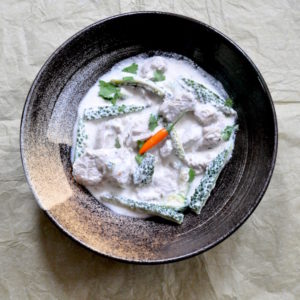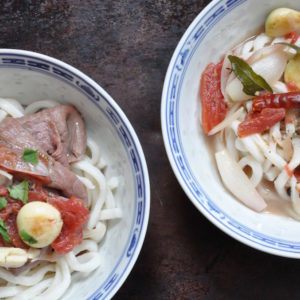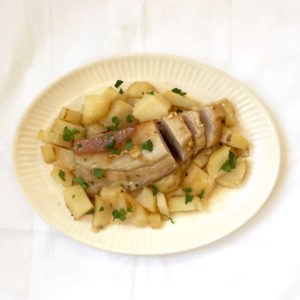Pork Rib Curry
I apologize for the quiet around here.
We live about thirty miles south of Santa Rosa, California. As I write, firefighters are slowly gaining control over the fires. People are returning to their homes, or what’s left of them.
Berkeley Fire Engine Six was called to help fight the fires last week. One firefighter shot video as they rolled into Santa Rosa to help fight what they thought was a grass fire. The video–which I warn you is graphic–describes events far better than I can.
—
Ribs don’t leap to mind as the ideal cut for a curry. I’d bought them for another recipe, which never happened. The ribs languished in the freezer, needing using. And I needed a curry.

Pork Rib Curry is nowhere near authentic: to begin with, I am an American Jew. Nor have I ever visited Thailand, much as I’d like to. Until that day, I console myself by preparing facsimiles of Thai food in my inadequate and far-from-Instragrammable kitchen. Which is not pictured.

Then again, living as I do in Northern California, I am lucky to still have a kitchen, Instagrammable or no. I am also fortunate to have numerous Southeast Asian neighbors, meaning ingredients like lemongrass, lime leaves, and coconut milk are easily located.

This said, if you are unable to locate lemongrass or lime leaves, don’t fret. This recipe, like its author, is extremely flexible.

On this note, while I crave searingly spicy curries, others don’t share this predilection. Adjust your preferences accordingly. Also know that the coconut milk will calm what initially appears to be an extremely fiery pot of food.

The result, to quote John, is very “moreish”–the rib meat is carved from the bones and sliced for ease of eating. (The bones are cook’s treat.) Shrimp paste and fish sauce add salty depth, while aromatics garlic, ginger, and shallot contribute their essential allium sweetness. Lemongrass and lime leaves lend a citrus note, and coconut milk rounds out the dish. You could eat pork rib curry over rice, but I think it’s best with wide egg noodles, whose textured surfaces capture bits of sauce.

Finally, while much of this recipe came out of my head, said head was filled with information from books like Hot, Sour, Salty, Sweet and Thailand The Beautiful Cookbook.
Pork Rib Curry
Cooking time: about 90 minutes
serves 2-3, but easily scaled upward
1 teaspoon shrimp paste
peanut or sunflower oil, for the pot
1-2 tablespoons homemade or commercial red curry paste (recipe is below; Thai Kitchen is a good commercial brand)
2-3 large garlic cloves, smashed and finely chopped
1/2 shallot lobe, peeled and finely chopped
1-3 stalks lemongrass, peeled down to the soft part and minced (see notes)
4 lime leaves, slivered, or juice of one regular lime (see notes)
1/4 cup fish sauce (Nam Pla)
1 large russet potato, peeled and cubed (optional)
1 daikon radish, peeled and sliced (optional)
approximately 1 1/2 pound pork ribs, sliced in half if necessary to fit your pot
1 thirteen-ounce can full-fat coconut milk
1 cup low-salt chicken broth or water, as needed
cilantro, for the top (optional)
8 ounces dried pappardelle or other wide egg noodles of your choice
To make the curry:
You will need a lidded oven-safe casserole pan of cast iron, enameled cast-iron, or oven-safe glass. I used a Staub “Everyday” pan.
Allow the pork to come to room temperature.
Preheat the oven to 325F.
Begin by wrapping the shrimp paste in a piece of tinfoil. Place the foil package in a small frying pan and cook over low heat for about 4 minutes. Allow to cool completely.
Place a 4-quart lidded heavy cast-iron, enameled cast iron pan, stove-top/oven-safe glass casserole on the oven burner over medium-low heat. Add enough peanut oil to coat the bottom of the pot; in my pan this is about 2 1/2 tablespoons. Allow this to heat. Add the red curry paste and allow to cook gently for about two minutes, stirring. How much paste you use is matter of personal preference; homemade is very fiery, but the coconut milk tones it down considerably. Taste a small amount if you are not sure.
Add the garlic, shallot, lemongrass, shrimp paste, lime leaves (or lime juice) and fish sauce. Increase the heat to medium and cook, stirring, for three to four minutes, letting the aromatics blend. If the food is browning too quickly or the liquid is rapidly cooking off, turn the heat down.
Add the optional potato and/or daikon radish to the pan. Add the pork. Allow them to sizzle for a few minutes.
Pour the coconut milk over all, place the lid on the pan, and slide into the oven.
Check the curry after 20 minutes to see whether additional liquid is required. This is not particularly saucy, but I added another cup of chicken broth. If you have no broth, water is fine. You can also add more coconut milk; any leftover from a fresh can freezes well.
Pork Rib Curry is ready when pork is completely tender and bones slip easily from meat. This takes about 90 minutes.
If you intend to serve the curry immediately, put a 4-quart saucepan of salted water on to boil. When the water is boiling, prepare your noodles following package instructions. Drain and divide between two deep bowls.
To serve curry, carve the meat from the bones–a messy but easy job. I did it by lifting the racks right in the pot and sliding a chef’s knife down each rib. Do take care handling hot food, and do save the bones for your own personal nibbling. You can slice the meat into squares before serving, or leave this to your diners. Spoon curry over the noodles and sprinkle a little cilantro over, if desired.
Pork Rib Curry is even better if allowed an overnight rest in the refrigerator.
Leftover curry will keep in a covered container, refrigerated, up to four days. Reheat in microwave or low oven; the curry need a little water on reheating.
Notes:
This isn’t an especially saucy curry. If you prefer a wetter curry, feel free to add more coconut milk. Any unused portion will freeze well.
Lemongrass ranges from spindly to thick. If yours is spindly, use more. Thick, use less. If you cannot find it, leave it out.
Lime leaves are sometimes found in produce sections where “Asian vegetables” are sold. Lime leaves are also bagged and sold frozen. They keep well in the freezer. It’s best to remove them from the dish before serving.
—
Red Curry Paste
From Thailand The Beautiful Cookbook
Yield: about two cups
one small onion or shallot, peeled and roughly chopped to equal four ounces
8 garlic cloves, peeled and roughly chopped
10 dried red Thai chili peppers (use less if you wish, but this is supposed to very hot)
4 thin slices of fresh galangal root (substitute fresh ginger if you cannot find galangal)
6 lemongrass stalks, peeled and chopped
1 tablespoon cilantro leaves
1/2 teaspoon ground cumin
1 teaspoon shrimp paste (wrap it in foil, place in small frying pan, and cook over low heat, four minutes. Allow to cool before unwrapping.)
1 teaspoon salt
3 tablespoons peanut or sunflower oil
Blend the onion, garlic, chili peppers, galangal root, lemongrass, cilantro, cumin, shrimp paste, and salt in a mini-processor or food processor. Heat the oil in a frying pan over medium heat and gently fry the curry paste for five minutes. Note the fumes are strong, so avert your face. Take care handling hot peppers. Wash your hands and the processor with hot soapy water.
The paste will keep, refrigerated, in a sterilized jar, up to 8 weeks.
If you prefer a less fiery condiment, use fewer chilis.
I forgot to take my usual “empty bowl” picture….so here’s dessert.





